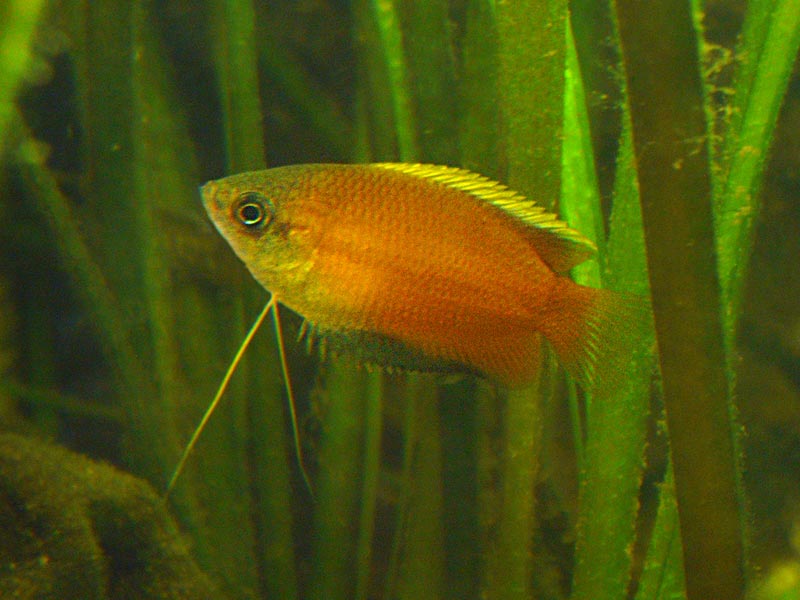 |
| Honey Gourami. Licensed under CC BY-SA 3.0 via Commons. |
The females grow bigger than the males and usually have a horizontal brown coloured stripe. The males have a more pointed anal fin.
Inbreeding condition, it is very easy to distinguish males from females: males are yellow-orange with a bright yellow dorsal fin and the underside of the abdomen velvety black, orange and blue on the neck, while females are almost uniformly brown.
Breeding
An increase in temperature will help to stimulate breeding. Although the adults can be kept in moderately hard water, for breeding the water needs to be fairly soft, with a maximum hardness of 8 degrees of general hardness. The water should be slightly acidic. These changed water conditions, including the temperature, will need to be maintained for several weeks to raise the fry.
Nest
The Honey Dwarf Gourami, like many of its relatives, is a bubble nest builder. The larger types of gourami like the Blue Gourami build their nests at the surface while the very small ones like the Sparkling Gourami build them under a leaf. The Honey Dwarf Gourami is the smallest of its genus but is bigger than the smallest gouramis. Although the Honey Dwarf Gourami will build under a leaf if a suitable one is available, it is also quite prepared to build at the surface, often in a corner of the tank.
As with the other species of gourami, it is the male that builds the nest and tries to get the female to come and spawn under it. He is gentler than many of his relatives. He will swim vertically in front of the female and swim towards the nest to get her to follow him.
A slightly unusual feature of this fish is that the male often will build either a nominal (small) nest or even no nest until spawning is complete, and then construct a fairly large nest around the eggs.
While they are actually spawning, the male curls his body around the female, turning her upside down with their vents close together so that he releases his sperm as she releases her eggs. The eggs float towards the nest and he gathers up any stray ones and puts them into the nest.
The male will protect the nest with the eggs in. This includes spitting drops of water onto the top of the nest which forces the bubbles down into the nest. This water would also help to ensure that the eggs have sufficient oxygenated water near them.
If you are breeding this fish there should be no other fish present. The eggs and fry are very vulnerable to predation. The little male will do his best to protect his nest with the babies in. This fish is normally one of the most peaceful of the gouramis, but when guarding his nest, the male Honey Dwarf Gourami has been known to mount a heroic defence against bigger fish, even occasionally killing the other fish.
The eggs hatch in 24-30 hours and the fry are free-swimming in 4-5 days.
Raising the Babies
All other fish should have been removed from the tank. The baby Honey Dwarf Gouramis are very small. They will need infusoria for a while before they can tackle live food visible to unaided human eyes.

No comments:
Post a Comment